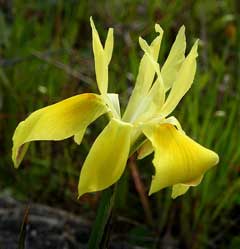 |
|
http://commons.wikimedia.org/wiki/User:Andrew_massyn |
 |
| http://commons.wikimedia.org/wiki/User:Andrew_massyn |
Translate this page:
Summary
Physical Characteristics

 Moraea fugax is a CORM growing to 0.5 m (1ft 8in).
Moraea fugax is a CORM growing to 0.5 m (1ft 8in).
See above for USDA hardiness. It is hardy to UK zone 9 and is frost tender. It is in flower from August to September, and the seeds ripen in September. The species is hermaphrodite (has both male and female organs) and is pollinated by Insects.
Suitable for: light (sandy) soils and prefers well-drained soil. Suitable pH: mildly acid, neutral and basic (mildly alkaline) soils. It cannot grow in the shade. It prefers dry or moist soil.
UK Hardiness Map
US Hardiness Map
Synonyms
M. edulis. (L.f.)Ker-Gawl.
Plant Habitats
Cultivated Beds; South Wall. By. West Wall. By.
Edible Uses
Edible Parts: Root
Edible Uses:
Bulb - cooked[105]. Palatable and nourishing, with a flavour that is like sweet chestnuts or potatoes[2, 42, 183].
References More on Edible Uses
Medicinal Uses
Plants For A Future can not take any responsibility for any adverse effects from the use of plants. Always seek advice from a professional before using a plant medicinally.
None known
References More on Medicinal Uses
The Bookshop: Edible Plant Books
Our Latest books on Perennial Plants For Food Forests and Permaculture Gardens in paperback or digital formats.

Edible Tropical Plants
Food Forest Plants for Hotter Conditions: 250+ Plants For Tropical Food Forests & Permaculture Gardens.
More

Edible Temperate Plants
Plants for Your Food Forest: 500 Plants for Temperate Food Forests & Permaculture Gardens.
More

More Books
PFAF have eight books available in paperback and digital formats. Browse the shop for more information.
Shop Now
Other Uses
References More on Other Uses
Cultivation details
Requires a light gritty well-drained soil and a sunny position[42, 79, 200]. The bulbs must be kept dry whilst they are dormant[79, 200]. This species is not quite hardy in Britain, though it does well in a cold greenhouse or cool conservatory[1, 200]. The corms should be planted about 12cm deep. Individual flowers only live for 6 hours, though the plant produces a succession of blooms during the flowering period[42].
References Carbon Farming Information and Carbon Sequestration Information
Temperature Converter
Type a value in the Celsius field to convert the value to Fahrenheit:
Fahrenheit:
The PFAF Bookshop
Plants For A Future have a number of books available in paperback and digital form. Book titles include Edible Plants, Edible Perennials, Edible Trees,Edible Shrubs, Woodland Gardening, and Temperate Food Forest Plants. Our new book is Food Forest Plants For Hotter Conditions (Tropical and Sub-Tropical).
Shop Now
Plant Propagation
Seed - best sown as soon as it is ripe in a warm greenhouse. A spring sowing in the greenhouse has proved very successful with us[K]. Sow the seed thinly so that the young plants can be grown on in the pot without disturbance for their first year. Give an occasional liquid feed to ensure that the plants do not become nutrient deficient. Pot up the small bulbs at the end of their first growing season, placing 2 - 3 bulbs in each pot. Grow them on in the greenhouse for another 2 years before planting them out into their permanent positions when they are dormant in the autumn. Division of offsets whilst the plants are dormant from September to January. The larger bulbs can be replanted immediately into their permanent positions, but it is best to pot up the smaller bulbs and grow them on for a year before planting them out in the autumn.
Other Names
If available other names are mentioned here
Native Range
Coming Soon
Weed Potential
Right plant wrong place. We are currently updating this section.
Please note that a plant may be invasive in one area but may not in your area so it’s worth checking.
Conservation Status
IUCN Red List of Threatened Plants Status :

Growth: S = slow M = medium F = fast. Soil: L = light (sandy) M = medium H = heavy (clay). pH: A = acid N = neutral B = basic (alkaline). Shade: F = full shade S = semi-shade N = no shade. Moisture: D = dry M = Moist We = wet Wa = water.
Expert comment
Author
(Delaroche.)Jacq.
Botanical References
73200
Links / References
For a list of references used on this page please go here
Readers comment
| Add a comment |
|
If you have important information about this plant that may help other users please add a comment or link below. Only comments or links that are felt to be directly relevant to a plant will be included. If you think a comment/link or information contained on this page is inaccurate or misleading we would welcome your feedback at [email protected]. If you have questions about a plant please use the Forum on this website as we do not have the resources to answer questions ourselves.
* Please note: the comments by website users are not necessarily those held by PFAF and may give misleading or inaccurate information.
To leave a comment please Register or login here All comments need to be approved so will not appear immediately.
|
|